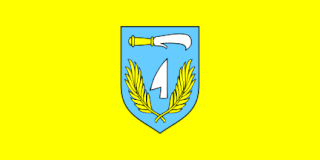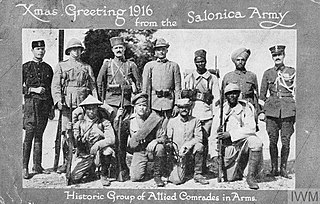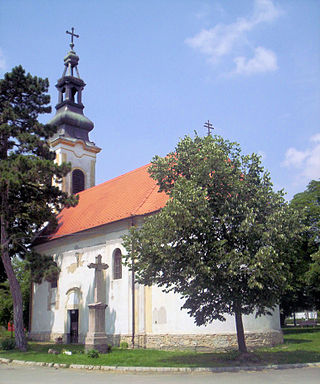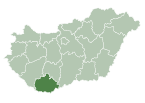
Petlovac is a village and municipality in the western part of Baranja, which comprise the northern part of Osijek-Baranja County in Croatia. Petlovac is underdeveloped municipality which is statistically classified as the First Category Area of Special State Concern by the Government of Croatia.

Hercegszántó is a village in the Bács-Kiskun County of Hungary, famous for being the birthplace of footballer Flórián Albert. Residents are Magyars, with minority of Serbs and Croats. Until the end of World War II, the Danube Swabians lived in this village, it was the only village of Stifulder, in the Bács-Kiskun county. The Stifulder are a Roman Catholic subgroup of the Danube Swabians whose ancestors arrived in the 17th and 18th centuries from Fulda (district). Majority of the Danube Swabians was expelled to Allied-occupied Germany and Allied-occupied Austria in 1945–1948, as a result of the Potsdam Agreement.

World War II in the Kingdom of Yugoslavia began on 6 April 1941, when the country was invaded and swiftly conquered by Axis forces and partitioned among Germany, Italy, Hungary, Bulgaria and their client regimes. Shortly after Germany attacked the USSR on 22 June 1941, the communist-led republican Yugoslav Partisans, on orders from Moscow, launched a guerrilla liberation war fighting against the Axis forces and their locally established puppet regimes, including the Axis-allied Independent State of Croatia (NDH) and the Government of National Salvation in the German-occupied territory of Serbia. This was dubbed the National Liberation War and Socialist Revolution in post-war Yugoslav communist historiography. Simultaneously, a multi-side civil war was waged between the Yugoslav communist Partisans, the Serbian royalist Chetniks, the Axis-allied Croatian Ustaše and Home Guard, Serbian Volunteer Corps and State Guard, Slovene Home Guard, as well as Nazi-allied Russian Protective Corps troops.

The Macedonian front, also known as the Salonica front, was a military theatre of World War I formed as a result of an attempt by the Allied Powers to aid Serbia, in the autumn of 1915, against the combined attack of Germany, Austria-Hungary and Bulgaria. The expedition came too late and with insufficient force to prevent the fall of Serbia and was complicated by the internal political crisis in Greece. Eventually, a stable front was established, running from the Albanian Adriatic coast to the Struma River, pitting a multinational Allied force against the Bulgarian army, which was at various times bolstered with smaller units from the other Central Powers. The Macedonian front remained stable, despite local actions, until the Allied offensive in September 1918 resulted in Bulgaria capitulating and the liberation of Serbia.

The Armistice of Salonica was the armistice signed at 10:50 p.m. on 29 September 1918 between Bulgaria and the Allied Powers at the General Headquarters of the Allied Army of the Orient in Thessaloniki. The armistice came into force at noon on 30 September 1918. The armistice would remain in effect until the conclusion of the Treaty of Neuilly-sur-Seine, the final general peace treaty, in November 1919.
Beremend is a village in Baranya County, Hungary on the Croatian border, it constitutes the southernmost point of the country. Residents are Magyars, with minority of Serbs. Until the end of World War II, the inhabitants were Danube Swabians, also referred to locally as Stifolder, because their ancestors arrived in the 17th and 18th centuries from Fulda (district). Most of the former German settlers were expelled to Allied-occupied Germany and Allied-occupied Austria in 1945–1948, consequent to the Potsdam Agreement. Only a few Germans of Hungary live there, the majority today are the descendants of Hungarians from the Czechoslovak–Hungarian population exchange. They got the houses of the former Danube Swabian inhabitants.

Illocska,, is a village in Baranya county, Hungary. Residents are Magyars, with a minority of Serbs and Danube Swabians. Until the end of World War II, the majority of the inhabitants were Roman Catholic Danube Swabians (Schwowe), their ancestors arrived in 1790 from Nagyszékely and Gyönk villages to Illocska. Most of the former German settlers were expelled to allied-occupied Germany and allied-occupied Austria in 1946–1948, following the Potsdam Agreement. Only a few Germans of Hungary live there, the majority today are the descendants of Hungarians from the Czechoslovak–Hungarian population exchange. They got the houses of the former Danube Swabian Inhabitants.

Majs is a village in Baranya County, Hungary. Residents are Magyars, with a minority of Danube Swabians and Serbs.

Trotta is a 1971 West German film directed by Johannes Schaaf. It is based on the 1938 novel Die Kapuzinergruft by Austrian author Joseph Roth. It was chosen as West Germany's official submission to the 45th Academy Awards for Best Foreign Language Film, but did not manage to receive a nomination. It was also entered into the 1972 Cannes Film Festival.

At the outbreak of World War I in August 1914, the Kingdom of Greece remained neutral. Nonetheless, in October 1914, Greek forces once more occupied Northern Epirus, from where they had retreated after the end of the Balkan Wars. The disagreement between King Constantine, who favoured neutrality, and the pro-Allied Prime Minister Eleftherios Venizelos led to the National Schism, the division of the state between two rival governments. Finally, Greece united and joined the Allies in the summer of 1917.
The Battle of Gallipoli was fought at the end of 1312 or in 1313, between the Byzantines and the Turcopoles led by Halil Pasha. For two years, Thrace was occupied by Halil Pasha. Earlier, Byzantine Emperor Michael IX Palaiologos had raised an army which defeated the Turcopoles, and confined them to a fortified camp in the Gallipoli peninsula. These Turcopoles numbered less than 2,000. Michael next asked assistance from his son-in-law, Serbian King Stefan Milutin, and received a 2,000-strong Serbian cavalry troop. Milutin had earlier subdued the Turcopoles that took refuge in Serbia. The Byzantine and Genoese ships completed the blockade, the Genoese preventing the Turcopoles from escaping by sea. The Turcopoles first made unsuccessful attempts at breaking free, but decided to surrender to the Genoese, thinking they would not be harsh. However, in the night, by mistake, many Turcopoles fell into the hands of the Byzantines, who slaughtered them and took their belongings. The Genoese executed only those Turcopoles that had many valuables, so they could not get into the hands of the Byzantines, and the rest they sold as slaves. Halil and his men were all massacred. The Serbian contingent took share in the spoils. The Turcopoles had heavy casualties, with few survivors returning to Byzantine service, though little is heard of them afterwards. The victory was made a poem by Manuel Philes. In two chrysobulls of Andronikos II Palaiologos to the Serbian Hilandar monastery, dating to October 1313 and July 1317, he showed gratitude to Stefan Milutin for his aid, as detailed in the prefaces.

The Monastir offensive was an Allied military operation against the forces of the Central Powers during World War I, intended to break the deadlock on the Macedonian front by forcing the capitulation of Bulgaria and relieving the pressure on Romania. The offensive took the shape of a large battle and lasted for three months and ended with the capture of the town of Monastir. On an average depth of 50km, the Bulgarian First Army gave battle on six occasions, being forced to retreat five times.

Kisbudmér is a village and municipality in Baranya county, Hungary.
Lippó is a village in Baranya county, Hungary. Residents are Magyars, Germans of Hungary, with minority of Serbs. Until the end of World War II, the majority of the inhabitants were Danube Swabians, also called locally as Stifolder, because their ancestors arrived in the 17th and 18th centuries from Fulda (district). Most of the former German settlers were expelled to allied-occupied Germany and allied-occupied Austria in 1945–1948, under the Potsdam Agreement. Only a few Germans of Hungary live there, the majority today are the descendants of Hungarians from the Czechoslovak–Hungarian population exchange. They occupied the houses of the former Danube Swabian inhabitants.

István Iglódi was a Hungarian actor and stage director. He appeared in over 65 films and television shows between 1965 and 2008.

The Austro-Hungarian Armed Forces occupied Serbia from late 1915 until the end of World War I. Austria-Hungary's declaration of war against Serbia on 28 July 1914 marked the beginning of the war. After three unsuccessful Austro-Hungarian offensives between August and December 1914, a combined Austro-Hungarian and German offensive breached the Serbian front from the north and west in October 1915, while Bulgaria attacked from the east. By January 1916, all of Serbia had been occupied by the Central Powers.

The Testament of Aga Koppanyi is a 1967 Hungarian adventure film based on the eponymous novel by István Fekete.

SMS Admiral Spaun was a scout cruiser built for the Austro-Hungarian Navy. Named for Admiral and Marinekommandant Hermann von Spaun, Admiral Spaun was constructed shortly before World War I. Laid down at the Pola Navy Yard in May 1908, the cruiser was launched in October 1909. Admiral Spaun was commissioned into the Navy just over a year later, in November 1910. The first ship of the Austro-Hungarian Navy to be constructed with steam turbines, her design later influenced the construction of the Novara-class cruisers.

The Bulgarian occupation of Serbia of WW1 started in Autumn 1915 following the invasion of Serbia by the combined armies of Germany, Austria-Hungary and Bulgaria. After Serbia's defeat and the retreat of its forces across Albania, the country was divided into Bulgarian and Austro-Hungarian occupation zones.
The armistice of Belgrade was an agreement on the termination of World War I hostilities between the Triple Entente and the Kingdom of Hungary concluded in Belgrade on 13 November 1918. It was largely negotiated by General Louis Franchet d'Espèrey, as the commanding officer of the Allied Army of the Orient, and Hungarian Prime Minister Mihály Károlyi, on 7 November. It was signed by General Paul Prosper Henrys and vojvoda Živojin Mišić, as representatives of the Allies, and by the former Hungarian Minister of War, Béla Linder.

















